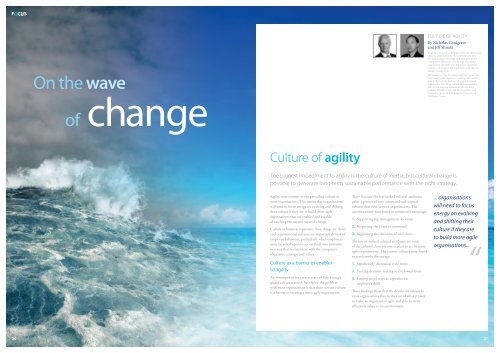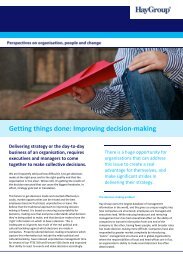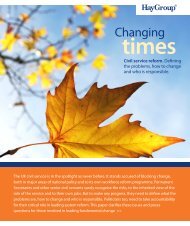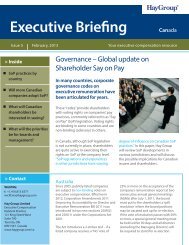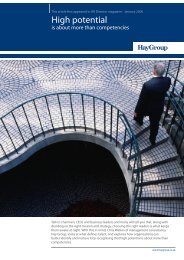Culture - Hay Group
Culture - Hay Group
Culture - Hay Group
Create successful ePaper yourself
Turn your PDF publications into a flip-book with our unique Google optimized e-Paper software.
On the wave<br />
of change<br />
CULTURE OF AGILITY<br />
By Nicholas Conigrave<br />
and Jeff Shiraki<br />
Nicholas is focused on helping CEO’s and their teams<br />
align the organisation to effectively execute their<br />
business strategy. He works with executive teams<br />
to help them deliver growth through improving<br />
organisation capability and alignment, successful<br />
execution of mergers and acquisitions and effective<br />
change management.<br />
Jeff Shiraki is a Vice President with <strong>Hay</strong> <strong>Group</strong> with<br />
over twenty years experience working with clients<br />
to help them clarify business strategies and align<br />
organisation structures, culture and management<br />
practices to improve business results. He holds<br />
a Master of Public Policy (M.P.P.) from Harvard<br />
University and an M.B.A. from the University of<br />
California, Irvine.<br />
<strong>Culture</strong> of agility<br />
The biggest impediment to agility is the culture of inertia, but cultural change is<br />
possible to generate long-term sustainable performance with the right strategy.<br />
Agility runs counter to the prevailing culture in<br />
most organisations. This means that organisations<br />
will need to focus energy on evolving and shifting<br />
their culture if they are to build more agile<br />
organisations that are enabled and capable<br />
of catching the current wave of change.<br />
<strong>Culture</strong> in business represents ‘how things are done’<br />
and organisational cultures are important drivers of<br />
employee behaviour, particularly when employees<br />
must be relied upon to act on their own initiative,<br />
in a way that is consistent with the company’s<br />
objectives, strategy, and values.<br />
<strong>Culture</strong> as a barrier or enabler<br />
to agility<br />
An investigation into seven years of <strong>Hay</strong> <strong>Group</strong>’s<br />
global culture research has shown the problem<br />
with most organisations is that their current culture<br />
is a barrier to creating a more agile organisation.<br />
That’s because the top-ranked cultural attributes<br />
paint a picture of very command-and-control<br />
cultures that exist in most organisations. The<br />
current cultures were found to consistently encourage:<br />
1. Supporting top management decisions<br />
2. Respecting the chain of command<br />
3. Supporting the decisions of one’s boss<br />
The lowest-ranked cultural attributes are some<br />
of the cultural elements one expects to see in more<br />
agile organisations. The current cultures were found<br />
to consistently discourage:<br />
1. Significantly decreasing cycle times<br />
2. Pushing decision-making to the lowest levels<br />
3. Finding novel ways to capitalise on<br />
employee’s skills<br />
These findings show that the dominant culture in<br />
most organisations flies in the face of what it takes<br />
to make an organisation agile and able to more<br />
effectively adapt to its environment.<br />
... organisations<br />
will need to focus<br />
energy on evolving<br />
and shifting their<br />
culture if they are<br />
to build more agile<br />
organisations...<br />
“<br />
26<br />
27
Local norms also<br />
act as a barrier to<br />
cultural change,<br />
with the ‘she’ll be<br />
right mate’ attitudes<br />
common in the<br />
workplace.<br />
“<br />
A culture of inertia<br />
In Australia and New Zealand, there have been<br />
many cases where successful companies have<br />
ignored fundamental shifts in the market and<br />
waited too long before re-aligning their culture<br />
to help achieve business results. Whether it’s<br />
traditional media organisations, paper-based<br />
search companies, or retailers not looking towards<br />
the internet, by the time they try to change their<br />
business model or strategy, it is too late, since<br />
a ‘culture of inertia’ locks them in place.<br />
Local norms also act as a barrier to cultural change,<br />
with the ‘she’ll be right mate’ attitudes common in<br />
the workplace. In an increasingly volatile globalised<br />
world, this type of attitude can no longer prevail.<br />
The time to act is now<br />
As leaders in the organisation, CEOs and executives<br />
have the capacity and the responsibility to shift<br />
the culture in their organisations by understanding<br />
their role in shaping the culture to better align with<br />
the needs of the strategy. This can be personally<br />
challenging as it requires executives to look at<br />
their own values, beliefs and behaviours in the<br />
organisation and question whether they are still<br />
relevant and appropriate for the times. This may<br />
involve blowing up their business model and<br />
fundamentally rethinking the organisation’s<br />
value proposition.<br />
It is difficult to tackle culture change head on.<br />
<strong>Culture</strong> change is a journey which takes time,<br />
and involves being deliberate about where your<br />
organisation is heading. It is about identifying the<br />
different levers – the practices, norms, symbols,<br />
processes and behaviours – influencing culture, and<br />
by changing these levers culture change occurs and<br />
is sustained over time.<br />
Simply sticking to what you are good at and hoping<br />
for the best is not good enough anymore – leaders<br />
need to act to develop and evolve their organisation<br />
culture to ensure that it supports and enables<br />
their staff to change the way they do business and<br />
continue to meet the needs of their customers. That<br />
is the recipe to long-term sustainable performance.<br />
Key steps to achieving culture change<br />
■<br />
■<br />
■<br />
■<br />
Understand the strategic requirements of<br />
your organisation: what type of culture is<br />
needed to deliver the short and long-term<br />
results you desire?<br />
Define the types of behaviours that will<br />
be required to help the organisation<br />
be successful.<br />
Prioritise the change levers that will produce<br />
the most impactful culture change.<br />
Focus on systematically implementing<br />
those catalysts for change over time.<br />
<strong>Culture</strong> change is a journey<br />
which takes time, and involves<br />
being deliberate about where<br />
your organisation is heading.<br />
Watch Nicholas summarise the key points of his article<br />
CASE STUDY:<br />
IBM’s culture change journey<br />
The success and longevity of IBM can be attributed<br />
to the organisation’s ability to change. IBM has<br />
learned over a century that culture isn’t just one<br />
of the tools of management; it is the purpose of<br />
management. The company also understands that<br />
words in corporate value statements, as powerfully<br />
as they may be expressed, are empty platitudes<br />
unless they are acted on rigorously and consistently<br />
in day-to-day business activities.<br />
Tom Watson Jr., the former Chairman and son<br />
of IBM’s founder, once said, “I believe that if an<br />
organisation is to meet the challenges of a changing<br />
world, it must be prepared to change everything<br />
about itself… except those (core) beliefs… as it<br />
moves through corporate life.” At IBM, those<br />
words are taken to heart, and are embodied<br />
in the organisational culture.<br />
In an age of unprecedented change and complexity,<br />
this sentiment remains both true and relevant<br />
to today’s IBM. One of the key competencies<br />
that IBM looks for in its leaders is the ability to<br />
‘continuously transform’ what they do and how<br />
they do it. Another key leadership competency<br />
is strategic risk taking. “You can’t transform a<br />
business without taking risk”, says Andrew Stevens,<br />
Managing Director of IBM Australia and<br />
New Zealand.<br />
At the heart of change and risk taking is innovation.<br />
IBM encourages innovation that matters for the<br />
company and for the world, developing intellectual<br />
property that has future application and innovation<br />
that solves problems in the community. This<br />
innovative application of technology means that<br />
work has shifted from creating innovative products,<br />
to the services business of helping clients realise<br />
their full potential, in business or the community.<br />
While these competencies are expected at the<br />
leadership level, IBM recognises the need to build<br />
future leaders by empowering front line staff with<br />
the ability to make decisions and resolve problems.<br />
Decision-making is therefore pushed right down<br />
to front-line staff. “All large organisations have a<br />
level of contention in them. That contention is best<br />
resolved as close to the client as possible”, says Stevens.<br />
In Australia and New Zealand, the organisation model<br />
is designed on this theory, with the matrix structure<br />
enabling front-line employees to resolve problems<br />
and to develop and implement solutions locally.<br />
Scan the QR code or go to:<br />
http://www.haygroup.com/au/focus13video6<br />
28<br />
29


